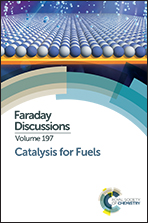Selective hydrogenation of CO on Fe3S4{111}: a computational study
Abstract
Fischer–Tropsch (FT) synthesis has been a recursive method to form valuable molecules from syngas. Metal surfaces have been extensively studied as FT catalysts; among them, iron presents several phases under reaction conditions, oxides and carbides, as active sites for the FT and reverse water gas shift reaction. We present CO reduction on an iron sulfide phase with spinel structure, Fe3S4, also considering the pathways where C–O dissociates leaving CHx species on the surface, which may feed longer aliphatic chains via the FT process. We analysed the thermodynamic and kinetic availability of each step leading to O and OH species co-adsorbed on the surface as well as the formation of H2O from the hydrogenation of the alcohol group in the molecule. This detailed analysis led to energy profiles on both active sites of the surface, and we conclude that this Fe3S4 surface is highly selective towards the formation of methanol, in full agreement with experimental results. These findings point out that the C–C bond formation on greigite takes place through a hydroxycarbene FT mechanism.
- This article is part of the themed collection: Catalysis for Fuels


 Please wait while we load your content...
Please wait while we load your content...